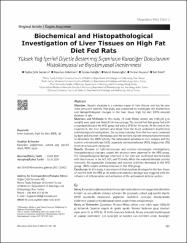| dc.contributor.author | Samancı, Tuğba Çelik | |
| dc.contributor.author | Gökçimen, Alpaslan | |
| dc.contributor.author | Kuloğlu, Tuncay | |
| dc.contributor.author | Boyacıoğlu, Murat | |
| dc.contributor.author | Kuyucu, Yurdun | |
| dc.contributor.author | Polat, Sait | |
| dc.date.accessioned | 2022-11-14T07:56:47Z | |
| dc.date.available | 2022-11-14T07:56:47Z | |
| dc.date.issued | 2022 | en_US |
| dc.identifier.citation | Samanci, T.C., Gokcimen, A., Kuloglu, T., Boyacioglu, M., Kuyucu, Y. & Polat, S. (2022). Biochemical and Histopathological Investigation of Liver Tissues on High Fat Diet Fed Rats. Meandros Medical and Dental Journal, 23(1), 101-107. http://doi.org/10.4274/meandros.galenos.2021.32932 | en_US |
| dc.identifier.issn | 2149-9063 | |
| dc.identifier.uri | http://doi.org/10.4274/meandros.galenos.2021.32932 | |
| dc.identifier.uri | https://hdl.handle.net/11436/7011 | |
| dc.description.abstract | Objective: Hepatic steatosis is a common cause of liver disease and has become more prevalent recently. This study was conducted to investigate the biochemical and histopathological changes in the liver tissue high fat diet (HFD)-induced steatosis in rats.
Materials and Methods: In this study, 16 male Wistar-albino rats (160 +/- 30 g in weight) were used and divided into two groups: The normal fed diet group fed with a standard diet and the HFD group fed with a HFD for 10 weeks. At the end of the experiment, the liver sections and blood from the heart underwent biochemical and histological investigations. The sections obtained from the liver were examined by light and electron-microscopy and the sections stained immunohistochemically to determine the iNOS activity. The antioxidant activities in liver samples and the alanine aminotransferase (ALT), aspartate aminotransferase (AST), triglyceride (TG) levels in serum were measured.
Results: Because of light-microscopy and electron-microscopic investigations, histopathological changes caused the steatosis were observed in the HFD group. The histopathological damage observed in the liver was confirmed biochemically with the increase in the ALT, AST, and TG levels. While the malondialdehyde activity increased, the superoxide dismutase and catalase activities decreased in the HFD group. iNOS enzyme activity increased in the HFD group.
Conclusion: In this study, it was observed that steatosis developed in the liver tissue of rats fed with the HFD at 10 weeks and oxidative damage was triggered with the influence of inflammation and activation of the antioxidant defense system. | en_US |
| dc.language.iso | eng | en_US |
| dc.publisher | Galenos Yayıncılık | en_US |
| dc.rights | info:eu-repo/semantics/openAccess | en_US |
| dc.subject | Liver steatosis | en_US |
| dc.subject | High fat diet | en_US |
| dc.subject | İNOS | en_US |
| dc.subject | Rat | en_US |
| dc.title | Biochemical and histopathological investigation of liver tissues on high fat diet fed rats | en_US |
| dc.title.alternative | Yüksek yağ içerikli diyetle beslenmiş sıçanların karaciğer dokularının histokimyasal ve biyokimyasal incelenmesi | en_US |
| dc.type | article | en_US |
| dc.contributor.department | RTEÜ, Tıp Fakültesi, Temel Tıp Bilimleri Bölümü | en_US |
| dc.contributor.institutionauthor | Samancı, Tuğba Çelik | |
| dc.identifier.doi | 10.4274/meros.galenos.2021.32932 | en_US |
| dc.identifier.volume | 23 | en_US |
| dc.identifier.issue | 1 | en_US |
| dc.identifier.startpage | 101 | en_US |
| dc.identifier.endpage | 107 | en_US |
| dc.relation.journal | Meandros Medical and Dental Journal | en_US |
| dc.relation.publicationcategory | Makale - Uluslararası Hakemli Dergi - Kurum Öğretim Elemanı | en_US |


















